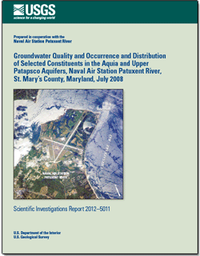The Naval Air Station Patuxent River in southern Maryland has continued to expand in the first decade of the 21st century, contributing to rapid population growth in the surrounding area. The increase in population has caused State and County water managers and others to be concerned about the impact of population growth on the quantity and quality of groundwater supplies. The U.S. Geological Survey has been investigating the groundwater resources of the air station since 1998. As part of that ongoing investigation, groundwater was sampled in 2008 in six wells in the Aquia aquifer and two wells in the Upper Patapsco aquifer in the vicinity of Naval Air Station Patuxent River and Webster Outlying Field. Groundwater samples were analyzed for basic chemistry (field parameters, major ions, and nutrients) as well as several water-quality issues of concern including the occurrence of arsenic and tungsten, and saltwater intrusion. The results of the 2008 groundwater-quality sampling indicate that the overall quality of groundwater in the Aquia aquifer has not changed since 1943; data are too limited to determine if groundwater quality has changed in the Upper Patapsco aquifer. At one well in the Aquia aquifer, the arsenic concentration exceeded the U.S. Environmental Protection Agency standard for drinking water. Arsenic was not detected in samples from the Upper Patapsco aquifer. Tungsten concentrations were detected at low concentrations near the laboratory reporting level in all eight samples. There was no evidence of saltwater intrusion in any of the wells.


